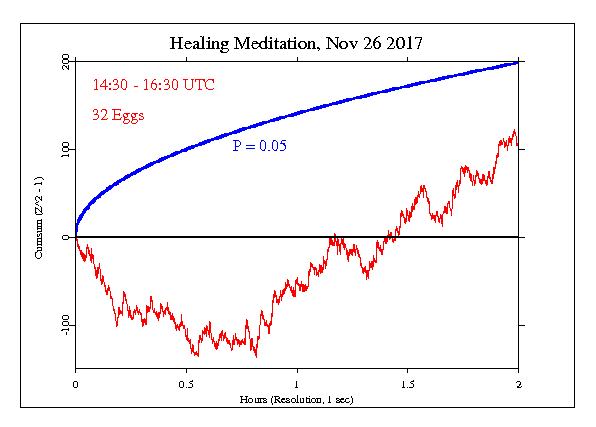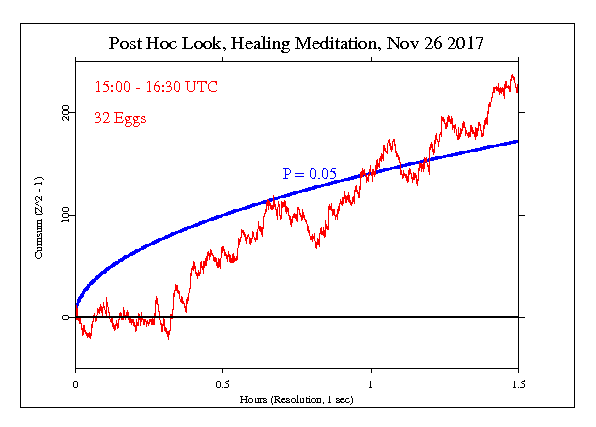Healing Meditation November 26 2017
An email from Sonia Sequeria, at Memorial Sloan Kettering Cancer Center, asked if the GCP might be able to monitor the effects of a large group meditation, whose purpose was to help with healing and the pain and anxiety associated with clinical treatments. While most GCP events are larger in scale, involving millions of people, we have assessed a number of events of modest size, notably including meditations, aimed at promoting global harmony. In important ways this is related to healing, albeit on a larger scale. We agreed to take a look, understanding that the clinical study would have other more conventional measures of pain and anxiety. Following is their description and request.
Dr. Ahmed and I lead several funded projects at Memorial Sloan Kettering (MSKCC) involving the use of meditation, in particular, mantram, for pain and anxiety in pediatric patients, and also adult populations. We are preparing a pilot, controlled study of the effect of a large (potentially greater than 100,000 people) healing meditation on pain and anxiety. This study will inform a later study at MSKCC.
While our primary measures will be pain and anxiety, we are interested in evaluating the effect through the global consciousness project, as a secondary measure. The event is scheduled for November 26, live and broadcast from Mexico City. In sequential years, the event has had 12,000, 15,00, 21,000 and over 100,000 people, the last being both live and real time streaming.
Specific Hypothesis and Results
Sonia provided the time and date of the planned group meditation, November 26, from 8:30 am-10:30 am CST (14:30 to 16:00 UTC). The statistical result of the analysis is Chisquare 7312.1 on 7200 degrees of freedom for p = 0.175 and Z = 0.935. This Z score reflects an effect that is larger than the average effect size across all GCP formal events, by a factor of more than 2. The graphic result below shows that for the first half hour of the meditation period, the data showed a downward trend (often seen in deep meditation events) followed by a strong upward trend for the rest of the time period. As noted in the caveat below, we cannot reliably interpret results from single tests of the hypothesis, but this outcome is consonant with the general pattern seen in global harmony events noted above.
Interpretation
The following graph is a visual display of the statistical result. It shows the second-by-second accumulation of small deviations of the data from what’s expected. Our prediction is that deviations will tend to be positive, and if this is so, the jagged line will tend to go upward. If the endpoint is positive, this is evidence for the general hypothesis and adds to the bottom line. If the endpoint is outside the smooth curve showing 0.05 probability, the deviation is nominally significant. If the trend of the cumulative deviation is downward, this is evidence against the hypothesis, and is subtracted from the bottom line. For more detail on how to interpret the results, see The Science and related pages, as well as the standard caveat below.

Post Hoc Assessment
Upon seeing the results from the formal hypothesis test, Sonia said it was notable that the inflection between the two segments coincided approximately with the beginning of the meditation period: "The 2nd phase (>30 min) was the meditation and yoga phase at approx the inflection point. How could we interpret this?" While post hoc analysis can't be taken as evidence in a scientific experiment, there is a very clear, persistent deviation in the last 1.5 hours, as is shown in the following figure.

Standard caveat
It is important to keep in mind that we have only a tiny statistical effect, so that it is always hard to distinguish signal from noise. This means that every success
might be largely driven by chance, and every null
might include a real signal overwhelmed by noise. In the long run, a real effect can be identified only by patiently accumulating replications of similar analyses.
